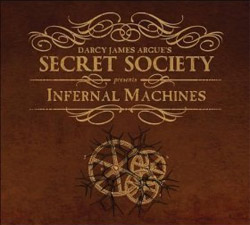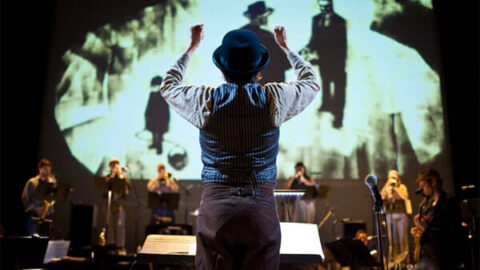 The best music is often that which makes the perfect soundtrack for its time, sounding completely “in the moment” yet drawing from its predecessors and opening up new possibilities for the future. The 4-night run of Brooklyn Babylon at Brooklyn Academy of Music’s Harvey Theatre this past week combined imaginative music and visual art to create a compelling theatrical performance that spoke directly to profound social questions of today. The innovative sounds of Darcy James Argue’s Secret Society and the provocative animation and live painting by Danijel Zezelj were a treat in their own right, and the performance was a riveting hour-long journey left you thinking, seeing, and hearing differently.
The best music is often that which makes the perfect soundtrack for its time, sounding completely “in the moment” yet drawing from its predecessors and opening up new possibilities for the future. The 4-night run of Brooklyn Babylon at Brooklyn Academy of Music’s Harvey Theatre this past week combined imaginative music and visual art to create a compelling theatrical performance that spoke directly to profound social questions of today. The innovative sounds of Darcy James Argue’s Secret Society and the provocative animation and live painting by Danijel Zezelj were a treat in their own right, and the performance was a riveting hour-long journey left you thinking, seeing, and hearing differently.

The storyline of the animation was of a robber baron-type mayor creating the tallest skyscraper in the middle of Brooklyn, transplants and longtime residents finding their neighborhood being transformed into a frightful new world, and a carpenter hired to design a carousel atop the skyscraper confronting the gap between his artistic pursuits and social responsibility. As such, its larger than life realism opened up a whole tangle of social contradictions churning our present lives. Secret Society functioned as a something of a pit-orchestra within this work of theatre, sometimes playing direct musical analogies to what was on-screen, and at other times exploring the animation’s themes in an indirect way.
Musically, Darcy James Argue achieved whole new sounds. While rooted in modern jazz, the music was able to evoke the past and draw in elements of the most cutting edge rock music – like a European big band but with ferocity and punch. While Argue charted unique rhythmic territory, a groove was always there to feel, without the need for intellectual analysis. The warm yet powerful bottom end provided by at times two tubas, bari sax, bass clarinet, euphonium and trombones gave the music drive and an ominous sound when put in the foreground. The trumpet section played with an incredible sensitivity to blend, and brass sound was malleable to the composer’s intentions. The wind section was holding flutes and clarinets far more often than saxophones, inventing a far more interesting blend of texture. The energy throughout was achieved overwhelmingly through more subtle means, making the moments of full scream volume all the more intense. The music as a whole was driven by a very real sense of drama fit for a stage show.
 After rave reviews of Secret Society’s Infernal Machines, Argue has proved both his unique creative impulse and his professionalism as a composer with the score of Brooklyn Babylon. He was able to create exactly the right kind of music for each moment, from the raging brass band at the beginning to the musical insanity set to the carousel spinning out of control. His ear for instrumentation blazes new paths for a big band.
After rave reviews of Secret Society’s Infernal Machines, Argue has proved both his unique creative impulse and his professionalism as a composer with the score of Brooklyn Babylon. He was able to create exactly the right kind of music for each moment, from the raging brass band at the beginning to the musical insanity set to the carousel spinning out of control. His ear for instrumentation blazes new paths for a big band.
One quality of a great composer is their ability to challenge performers to create new sounds and possibilities on their instrument. One got a sense of intense concentration and the sweat of hard work from each member of Secret Society. The detailed attention to getting just the right blends and textures was impressive, and it drew some great moments out of the band. One trumpet solo by Ingrid Jensen in particular stood out to me for its wide pitch bends on atmospherically high notes that were played with sensitivity rather than power. While the band’s performance was impressive, I’d have to venture that the improvisations were lagging behind the composition – still too rooted in the language of the jazz past rather than the new sounds of Argue’s compositions.

The best moment of the performance for me was when, at the end, Zezelj picked up a roller, dipped it in black paint, and began covering up the beautiful and intricate canvas he had created for the last hour. Some in the packed theatre were clearly uncomfortable with all that hard work and creation being “destroyed.” What impressed me about this gesture was the way in which it was treating art as something in the moment, with the act of creating being just as important as its finished product. The active and improvisatory element in this generated far more of a reaction and made a profound connection between music – which never sits still – and visual art.
A recent article on salon.com conveyed Argue and Zezelj’s sense of dilemma when they were busy creating art that deals with social inequalities while hundreds of people began occupying Wall St to deal with those social inequalities. Here I believe is where the two are profoundly connected by the act of imagination. Occupy Wall St is the first political movement in the US in quite some time that has existed outside of the realm of what’s possible under the present political alignment. As a recent article by Allen Yee put it, the pundits’ and politicians’ “demand for demands” on the movement is nothing more than an attempt to put it back into the acceptable (ineffectual) channels for dissent. Art’s value toward political struggles is not merely in being an appendage to such protest movements (even while artist support for them is crucial), but more profoundly in its ability to open up people’s imaginations and present new ways of thinking, hearing, and seeing. It is this sense of imagination that has been sorely lacking of late, and I believe art like that created by Argue and Zezelj can be of tremendous assistance in breaking out the prison of the possible.
A word is in order here about the symbolism of Brooklyn Babylon. Art’s power in speaking to social questions is often located in its ability for symbolism – for creating singular representations of large and complex social contradictions. The animation’s use of a complexity of characters confronting their own place within these social contradictions was excellent in this respect, and the carpenter’s agonizing over his detachment from the people needs to be confronted by today’s generation of artists (and locating the story in Brooklyn was a great way of making this challenge quite direct). The image of the robber baron-type villain and the band’s newsies-type garb worked well artistically and symbolically, but perhaps demonstrate a weakness of our present post-ideological condition. Representing the singular with imagery harking back a century fits in with a trend of nostalgia for the past and a lack of locating today’s equivalents. Perhaps the social contradictions being represented would have hit home more if the band had donned aprons and paco jeans, and the robber baron figure was instead a hip philanthropic communications technology CEO. These comments should not be taken as an artistic critique – in that respect the imagery was impressive – but more as a political critique on the fact that often the social actors of the past are evoked rather than the antagonists of today, with the effect of avoiding our responsibility to pick a side in the present.
—
David Pearson is a saxophonist residing in NYC.
























